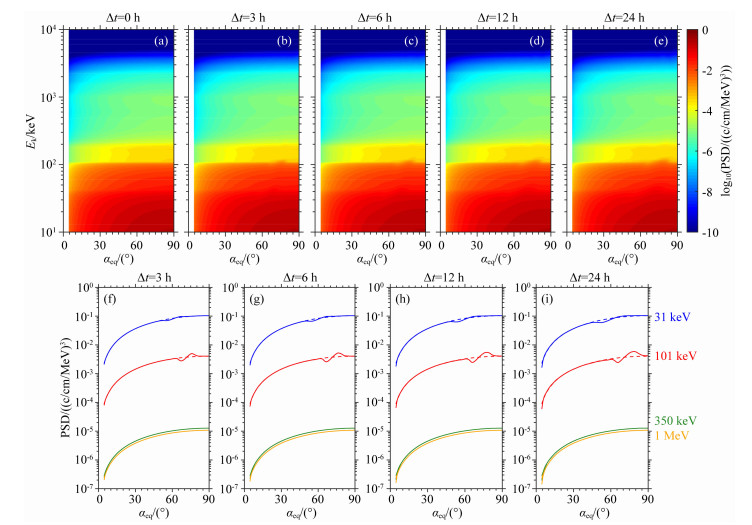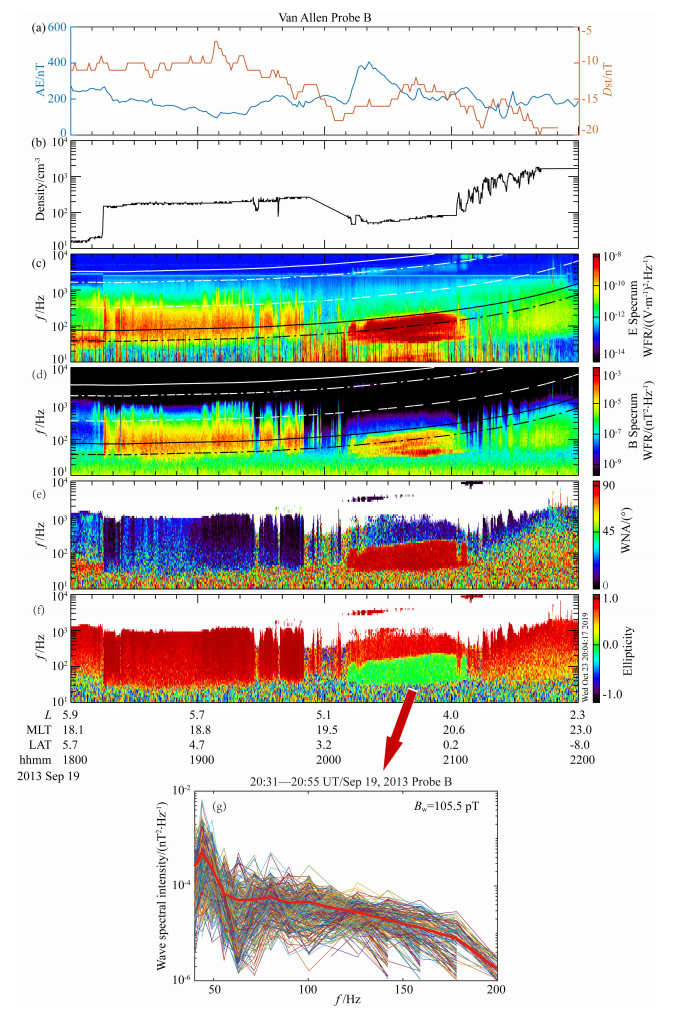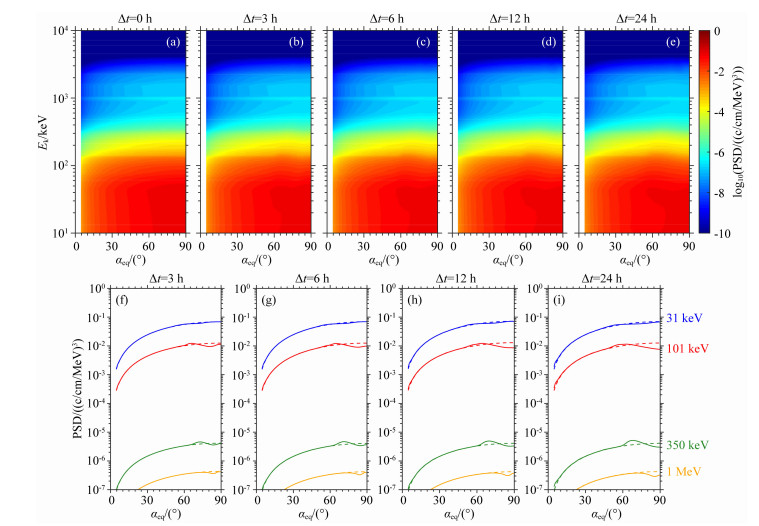2. 中国科学院比较行星学卓越创新中心, 合肥 230026
2. Center for Excellence in Comparative Planetology, Chinese Academy of Sciences, Hefei 230026, China
地球辐射带位于地球内磁层,是一个充满了被地球磁场捕获的高能带电粒子的区域,分为内辐射带和外辐射带.其中,外辐射带大约位于(3~8)RE(RE为地球半径)之间,且充满了大量的高能电子和高能质子(Baker et al., 1986; Li et al., 1997; Gu et al., 2020; Xiang et al., 2020).由于受到太阳活动的影响,外辐射带电子通量及其能量、投掷角的分布显现出高度的动态变化,这些变化与电子的运输、加速和损失过程相关.我们知道,在空间等离子体波和辐射带电子之间存在能量交换的过程(Zong et al., 2007, 2009, 2011; Thorne, 2010; Thorne et al., 2013; Ni et al., 2020).其中,磁声波(也被称为赤道噪声)在辐射带电子动力学中同样起着重要的作用.磁声波是高度倾斜于背景磁场传播的电磁辐射,其频率范围在质子回旋频率(fcp)和低混杂共振频率(fLHR)之间(Russell et al., 1970; Perraut et al., 1982; Laakso et al., 1990; Santolík et al., 2002).一般认为磁声波的波谱为分立谱(Fu et al., 2014; Balikhin et al., 2015),并在质子回旋频率的谐波上发生,但近来有模拟研究指出磁声波的波谱也可以呈现连续谱的形式(Sun et al., 2016a, b).磁声波主要分布于等离子体层顶内外,地球磁赤道5°范围内且距离地球表面(2~8)RE,其传播方向近似垂直于磁力线(Kasahara et al., 1994; Chen and Thorne, 2012).众多研究显示,磁声波与内磁层质子的环分布密切相关(Boardsen et al., 1992; Horne et al., 2000; Chen et al., 2011; Ma et al., 2014).新研究表明,在行星际激波作用下,产生的磁尾高速流能携带能量质子注入到内磁层,引起辐射带中质子分布的变化进而激发磁声波,因此内磁层磁声波的产生与磁尾高速流及其触发的磁尾-内磁层耦合过程也具有关联性(Hao et al., 2014; Liu et al., 2019).磁声波不但能够通过波粒相互作用散射电子,使辐射带电子分布函数形成投掷角蝴蝶状分布(Horne et al., 2007; Xiao et al., 2015; Li et al., 2016),而且还可以能化背景等离子体:对于均匀背景磁场条件,准垂直传播的磁声波能够在垂直方向上能化冷质子,并同时在垂直和平行方向上能化冷电子(Sun et al., 2017);对于偶极子背景磁场条件,磁声波表现出分别在垂直和平行方向上能化冷质子和冷电子(Chen et al., 2018).
本文介绍了一种伴随等离子体密度下降的磁声波,对发生于2013年7月26日和2013年9月19日的两个代表事件进行了详细分析.利用试验粒子模拟方法,我们计算两个事件中磁声波对电子的弹跳平均扩散系数,并通过求解二维福克-普朗克扩散方程模拟磁声波对电子的散射作用.结果表明,这一特殊类型的磁声波能显著影响外辐射电子的演变过程,导致电子的蝴蝶状投掷角分布.
1 仪器与数据本文主要使用范阿伦双卫星的波动和粒子观测数据.发射于2012年8月30日的范阿伦双星,轨道倾角~10°,其近地点为~1.1RE,远地点为~5.9RE(Mauk et al., 2013),轨道周期~9 h.这两颗卫星(卫星A和B)配备有高精度的波动与粒子测量仪器,能精确地提供磁层内等离子体波的数据.集电、磁场仪器于一体的综合性科学仪器磁强计和电磁波仪(EMFISIS)能提供背景磁场、波的电场与磁场数据(Kletzing et al., 2013).其中,波仪器中的波形接收机(WFR)可以测量电场和磁场三个分量的波功率谱密度,频率范围在10 Hz~12 kHz.利用奇异值分解法,可以计算波的传播角和极化率.波仪器中的高频接收机(HFR)测量电场谱密度,其频率范围在10~400 kHz,覆盖了内磁层大部分的上混杂共振频率(fUHR),可用于计算背景电子密度从而判断等离子体层顶的位置(Kurth et al., 2015).此外,利用氦氧质子电子质谱仪、磁性电子离子光谱仪(MagEIS)(Blake et al., 2013; Spence et al., 2013)和相对论电子质子望远镜(REPT)(Baker et al., 2013)能得到高能电子及兆电子伏特电子的数据.
基于磁声波被约束在赤道附近的特性,将其传播角设定为固定值θ=89°,且纬度范围≤|±3°|.在后续的计算中使用偶极地磁场模型,并利用范阿伦卫星的Level4数据集得到背景电子密度,且认为其不随纬度变化.
2 具体的事件分析 2.1 事件A:2013-07-26日伴随等离子体密度下降的磁声波事件A发生于2013年7月26日08 : 11—08 : 43 UT.图 1a展示了AE和Dst指数,显示出这段时间处于地磁平静期((Dst)min~-10 nT)和中等亚暴活动中.图 1b是背景电子密度,在磁声波发生时,等离子体密度从200 cm-3降到了73 cm-3,在磁声波结束时,又从73 cm-3增加到了130 cm-3,可以认为该时段伴随有等离子体密度下降.图 1c—1f展示了波特性及频谱的测量结果,利用波形接收机(WFR)能清晰地观察到在08 : 11—08 : 43 UT时间段出现了很强的磁声波,该磁声波是高度倾斜的(图 1e描述的波传播角θ~90°),且为线性极化的(图 1f描述的波极化率θ~0°).图 1g展示了磁声波的功率谱密度随频率的变化,由其平均值计算出来的波振幅(Bw)为61.3 pT,频率范围为80~220 Hz.该时段赤道地磁场强度的均值Beq=362.63 nT,背景电子密度Ne0=73.6 cm-3.

|
图 1 范阿伦B卫星2013年7月26日的等离子体波的观测结果 (a) AE和Dst指数; (b)背景等离子体密度,由EMFISIS WFR测量得到的(c)波电场和(d)磁场频谱,表示MS波的强度; (e) WNA和(f)极化率; (g) 2013年7月26日08 : 11—08 : 43 UT在L=4.2处MS波的磁场强度随频率的变化和均值(粗红线).在图 1c和1d中,白色曲线表示电子回旋频率fce(实线)、0.5fce(点划线)和0.1fce(虚线),黑色曲线表示低混杂共振频率fLHR(实线)、0.5fLHR(点划线). Fig. 1 Plasma waves observations of Van Allen Probes B on 26 July 2013 (a) AE and Dst indices; (b) Background plasma density; (c) Wave electric and (d) Magnetic spectrum measured by EMFISIS WFR, demonstrating the MS waves intensities; (e) Wave normal angle, and (f) Ellipticity; (g) Scatterplot of the magnetic field spectral intensities of MS waves as a function of frequency during the period of 08 : 11—08 : 43 UT on 26 July 2013 at L=4.2, and the mean profile (thick red curves). In Figs. 1c and 1d, the white curves represent the electron gyrofrequency fce (solid), 0.5fce (dash dotted), and 0.1fce (dashed), and the black curves indicate the lower hybrid resonance frequency fLHR (solid) and 0.5fLHR (dash dotted). |
为了分析磁声波对电子的散射效应,本文计算弹跳平均的电子散射系数.常用的计算扩散系数的方法有试验粒子模拟(Bortnik and Thorne, 2010; Li et al., 2014; Fu et al., 2019, 2020)和准线性理论方法(Ni et al., 2017).本文中我们采用了试验粒子模拟(Fu et al., 2019)分析由朗道共振、弹跳共振和渡越时间扩散引起的联合散射效果.图 2显示了在磁声波的影响下,电子的投掷角、交叉(投掷角,动量)、动量扩散系数(从左到右:〈Dαα〉,〈|Dαp|〉, 〈Dpp〉)随赤道投掷角(αeq)和电子动能Ek变化的二维图.由图 2a可知,电子的投掷角扩散系数范围在10-10~10-5s-1,最大值出现在投掷角范围65°~70°,能级范围70~100 keV.在损失锥内投掷角散射系数非常小,仅为~10-8s-1,表明该磁声波不能导致电子损失.图 2c的动量扩散系数比投掷角扩散系数小,从而前者对电子的散射作用是弱于后者的.基于图 2a—2c的结果可认为磁声波是个可行的加速机制,磁声波能驱动能量范围在20~200 keV、投掷角范围在60°~80°的电子发生散射作用.由于扩散系数的峰值集中在朗道共振范围附近,因此在该联合散射作用中,朗道共振起主导作用,而弹跳共振和渡越时间效应的贡献相对较小.

|
图 2 在磁声波的影响下,电子的投掷角、交叉(投掷角,动量)、动量扩散系数(从左到右:〈Dαα〉,〈|Dαp|〉,〈Dpp〉)随赤道投掷角(αeq)和电子动能Ek变化的二维图 Fig. 2 Two-dimensional plots of drift- and bounce-average pitch angle, cross (pitch angle, momentum) and momentum diffusion coefficients (from left to right: 〈Dαα〉, 〈|Dαp|〉, 〈Dpp〉) as a function of equatorial pitch angle αeq and electron kinetic energy Ek by magnetosonic waves |
得到弹跳平均的电子散射系数后,通过求解二维的福克-普朗克扩散方程,分析在磁声波的影响下电子相空间密度(f)在一天内的演化过程.为了计算初始相空间密度,首先利用范阿伦B卫星的MagEIS和REPT观测得到在22 : 59—23 : 02 UT(大约在事件发生的前一个轨道)期间,投掷角为90°的电子通量数据.其次,依据以下公式将电子通量转变为电子相空间密度(Shprits et al., 2007; Ni et al., 2009)

|
(1) |
其中,j为电子通量,单位为(sr·s·cm2·keV)-1,pc的单位为MeV,相空间密度的单位为(c/cm/MeV)3.
进一步地,假设在偶极磁场中电子通量的投掷角分布满足sin(aeq),并计算所有投掷角对应的电子相空间密度,将其作为初始条件展现在图 3a中.对于投掷角边界条件,将损失锥内(αeq≤αL,其中sinαL=L-3/2(4-3/L)-1/4)的f置为0,在αeq=90°时设置∂f/∂αeq=0.对于能量的边界条件,当Ek=10 keV和Ek=10 MeV时,设置f为常量.

|
图 3 (a—e)在MS波的影响下,相应时间内电子PSD(Phase Space Density, 相空间密度)的二维演化图;(f—i)在L=4.2处,模拟电子PSD(实线)在(f) Δt=3 h; (g) Δt=6 h; (h) Δt=12 h; (i) Δt=24 h的演化图,虚线表示初始电子PSD Fig. 3 (a—e) Two-dimensional temporal evolution of electron PSD under the impact of MS waves at the indicated interaction time stamps; (f—i) The temporal evolution of simulated electron PSDs (the solid lines) at (f) Δt=3 h; (g) Δt=6 h; (h) Δt=12 h; (i) Δt=24 h at L=4.2, with dashed line representing initial electron PSD |
图 3a—3e显示在磁声波的影响下,辐射带电子相空间密度的模拟演化过程的二维图.由于朗道共振,磁声波能使60°~80°间的电子发生散射且导致20~200 keV的电子产生水平加速,从而形成电子的蝴蝶状投掷角分布.
图 3f—3i给出了事件A中辐射带电子相空间密度随时间演化过程的模拟结果,从图中可以明显地看出,60°~80°间的电子受到了磁声波的散射作用,且能量范围在20~200 keV的电子得到的加速效果最强,这与上文中散射系数的共振区间相一致.基于磁声波对电子的散射作用,该区域形成了电子的蝴蝶状投掷角分布.
2.2 事件B:2013-09-19日事件B发生于2013年9月19日20 : 11—21 : 03 UT. 图 4a展示了AE和Dst指数,显示出该时段处于地磁平静期((Dst)min~-18 nT)和中等亚暴活动中.图 4b是背景电子密度,在磁声波发生时,等离子体密度从90 cm-3降到了68 cm-3,在磁声波结束时,又从68 cm-3增加到了350 cm-3.图 4c—4f是波的频谱及波特性的测量结果.从图中能看出在20 : 11—21 : 03 UT出现了很强的磁声波,它既是高度倾斜的(图 4e描述的波传播角θ~90°),也是线性极化的(图 4f描述的波极化率θ~0°).图 4g表示磁声波的功率谱密度随波频率的变化,由其平均值计算出来的波振幅(Bw)为105.5 pT,频率范围为40~200 Hz.该时段其平均的赤道地磁场强度Beq=284.49 nT,背景电子密度Ne0=68.8 cm-3.

|
图 4 范阿伦B卫星2013年9月19日的等离子体波的观测 AE和Dst指数; (b)背景等离子体密度,由EMFISIS WFR测量得到的(c)波电场和(d)磁场频谱,表示MS波的强度; (e) WNA和(f)极化率; (g) 2013年9月19日20 : 31—20 : 55 UT在L=4.36处MS波的磁场强度随频率的变化和均值(粗红线). Fig. 4 Plasma waves observations of Van Allen Probes B on 19 September 2013 (a) AE and Dst indices; (b) Background plasma density; (c) Wave electric and (d) Magnetic spectrum measured by EMFISIS WFR, demonstrating the MS waves intensities; (e) Wave normal angle, and (f) Ellipticity; (g) Scatterplot of the magnetic field spectral intensities of MS waves as a function of frequency during the period of 20 : 31—20 : 55 UT on 19 September 2013 at L=4.36, and the mean profile (thick red curves). |
利用与事件A同样的方法计算事件B的弹跳平均电子散射系数.图 5是在磁声波的影响下,电子的投掷角、交叉(投掷角,动量)、动量扩散系数(从左到右:〈Dαα〉, 〈|Dαp|〉, 〈Dpp〉)随赤道投掷角(αeq)和电子动能Ek变化的二维图.从图 5中我们能够看到朗道共振和弹跳共振对电子的联合散射效果比较明显.图 5a中电子的投掷角扩散系数的范围在10-9~10-5s-1,最大值出现在投掷角范围为70°~80°,能级范围为80~200 keV.在较低投掷角范围投掷角散射系数非常小,仅为~10-8s-1,说明该磁声波也不能导致电子损失.图 5c显示的动量扩散系数比投掷角扩散系数小,所以前者对电子的散射作用是弱于后者的.结合图 5a—5c的结果,可以认为该事件中的磁声波能导致电子的加速.通过朗道共振,磁声波能驱动能量范围在20~400 keV、投掷角范围在50°~80°之间的电子发生散射作用.与事件A相比,事件B中的磁声波产生的散射作用具有更宽的共振区间.

|
图 5 在磁声波的影响下,电子的投掷角、交叉(投掷角和动量)、动量扩散系数(从左到右:〈Dαα〉, 〈|Dαp|〉, 〈Dpp〉)随赤道投掷角(αeq)和电子动能Ek变化的二维图 Fig. 5 Two-dimensional plots of drift- and bounce-average pitch angle, cross (pitch angle, momentum) and momentum diffusion coefficients (from left to right: 〈Dαα〉, 〈|Dαp|〉, 〈Dpp〉) as a function of equatorial pitch angle αeq and electron kinetic energy Ek by magnetosonic waves |
同样,为了计算初始相空间密度,利用观测得到在11 : 50—11 : 54 UT(大约在事件发生的前一个轨道)期间投掷角为90°的电子通量数据,并依据公式(1)将电子通量转变为电子相空间密度.
图 6a—6e是在磁声波的影响下,辐射带电子相空间密度的模拟演化过程的二维图.从图中可以明显看出,磁声波能使投掷角范围为50°~80°、能量范围为20~400 keV的电子发生散射,形成了电子的蝴蝶状投掷角分布.

|
图 6 (a—e)在MS波的影响下,相应时间内电子PSD的二维演化图;(f—i)在L=4.36处,模拟电子PSD(实线)在(f) Δt=3 h; (g) Δt=6 h; (h) Δt=12 h; (i) Δt=24 h的演化图,虚线表示初始电子PSD Fig. 6 (a—e) Two-dimensional temporal evolution of electric PSD under the impact of MS waves at the indicated interaction time stamps; (f—i) The temporal evolution of simulated electron PSDs (the solid lines) at (f) Δt=3 h; (g) Δt=6 h; (h) Δt=12 h; (i) Δt=24 h at L=4.36, with dashed line representing initial electron PSD |
图 6f—6i给出了事件B中辐射带电子相空间密度随时间演化过程的模拟结果,图中显示出,投掷角在50°~80°范围内的电子受到了磁声波的散射作用,且在20~400 keV的能量范围内得到的加速效果最强,从而形成了电子的蝴蝶状投掷角分布.相较于事件A该事件的散射效果更强,这是因为事件B中的磁声波幅值比事件A中的更高,产生了更明显的影响.
3 结论与讨论在本研究中,我们观测到一种伴随等离子体密度下降的磁声波.在此基础上选取了两个典型的事件,并对由该磁声波产生的电子散射作用和外辐射带电子随时间的演化过程作了详细的分析探讨.首先根据试验粒子模拟计算弹跳平均扩散系数,并将其应用于解二维福克-普朗克扩散方程中,模拟外辐射带电子的运动过程.通过对两个事件的研究,主要有以下结论:
(1) 本文报道了一种伴随等离子体密度下降的磁声波,在波发生时背景等离子体密度开始下降,直到波结束时才上升.
(2) 利用试验粒子模拟方法计算扩散系数和求解二维福克-普朗克扩散方程,发现事件A和B中的磁声波均对电子有显著的散射作用,形成了电子的蝴蝶状投掷角分布.
(3) 磁声波对电子的散射作用受波幅的影响.由于事件B中的磁声波波幅比事件A更大,导致电子扩散系数更大,使得磁声波加速电子的效果比事件A更强.
值得注意的是,由于采用了一些前提假设,该研究结果会受到一些限制.首先,在计算扩散系数时假设波的功率谱密度、纬向分布均不随纬度改变,且采用的波传播角是基于以往的经验设置为常量89°.但实际情况中,扩散系数很可能会受到这些因素的影响.有研究表明,磁声波的扩散系数受波传播角和纬度影响较大(Lei et al., 2017).在后续的研究中,可以尝试定量研究这些因素对伴随等离子体密度下降的磁声波的具体影响.其次,模拟电子相空间密度时假设初始电子通量的投掷角分布是符合sin(αeq)的,从而提供在磁场偶极模型中大部分投掷角分布的合理近似.未来,更多与实际观测较为近似的计算模型能够被采用,以提供精确的初始相空间密度分布.
致谢 感谢范阿伦卫星EMFISIS、REPT和HOPE科学组织提供的所有数据.EMFISIS数据来源于http://emfisis.physics.uiowa.edu/data/index,MagEIS、REPT和HOPE数据来源于http://spdf.gsfc.nasa.gov/pub/data/,地磁活动指数来源于NASA OMNIWeb (http://cdaweb.gsfc.nasa.gov).
Baker D N, Blake J B, Klebesadel R W, et al. 1986. Highly relativistic electrons in the earth's outer magnetosphere:1.Lifetimes and temporal history 1979-1984. Journal of Geophysical Research:Space Physics, 91(A4): 4265-4276. DOI:10.1029/JA091iA04p04265 |
Baker D N, Kanekal S G, Hoxie V C, et al. 2013. The Relativistic Electron-Proton Telescope (REPT) Instrument on board the Radiation Belt Storm Probes (RBSP) Spacecraft:characterization of earth's radiation belt high-energy particle populations. Space Science Reviews, 179(1-4): 337-381. DOI:10.1007/s11214-012-9950-9 |
Balikhin M A, Shprits Y Y, Walker S N, et al. 2015. Observations of discrete harmonics emerging from equatorial noise. Nature Communication, 6: 7703. DOI:10.1038/ncomms8703 |
Blake J B, Carranza P A, Claudepierre S G, et al. 2013. The Magnetic Electron Ion Spectrometer (MagEIS) instruments aboard the radiation belt storm probes (RBSP) spacecraft. Space Science Reviews, 179(1-4): 383-421. DOI:10.1007/s11214-013-9991-8 |
Boardsen S A, Gallagher D L, Gurnett D A, et al. 1992. Funnel-shaped, low-frequency equatorial waves. Journal of Geophysical Research:Space Physics, 97(A10): 14967-14976. DOI:10.1029/92JA00827 |
Bortnik J, Thorne R M. 2010. Transit time scattering of energetic electrons due to equatorially confined magnetosonic waves. Journal of Geophysical Research:Space Physics, 115(A7): A07213. DOI:10.1029/2010JA015283 |
Chen L J, Thorne R M, Jordanova V K, et al. 2011. Magnetosonic wave instability analysis for proton ring distributions observed by the LANL magnetospheric plasma analyzer. Journal of Geophysical Research:Space Physics, 116(A3): A03223. DOI:10.1029/2010JA016068 |
Chen L J, Thorne R M. 2012. Perpendicular propagation of magnetosonic waves. Geophysical Research Letters, 39(14): L14102. DOI:10.1029/2012GL052485 |
Chen L J, Sun J C, Lu Q M, et al. 2018. Two-dimensional particle-in-cell simulation of magnetosonic wave excitation in a dipole magnetic field. Geophysical Research Letters, 45(17): 8712-8720. DOI:10.1029/2018GL079067 |
Fu H S, Cao J B, Zhima Z, et al. 2014. First observation of rising-tone magnetosonic waves. Geophysical Research Letters, 41(21): 7419-7426. DOI:10.1002/2014GL061867 |
Fu S, Ni B B, Zhou R X, et al. 2019. Combined scattering of radiation belt electrons caused by Landau and bounce resonant interactions with magnetosonic waves. Geophysical Research Letters, 46(17-18): 10313-10321. DOI:10.1029/2019GL084438 |
Fu S, Yi J, Ni B B, et al. 2020. Combined scattering of radiation belt electrons by low-frequency hiss:Cyclotron, Landau, and bounce resonances. Geophysical Research Letters, 47: e2020GL086963. |
Gu X D, Xia S J, Fu S, et al. 2020. Dynamic responses of radiation belt electron fluxes to magnetic storms and their correlations with magnetospheric plasma wave activities. The Astrophysical Journal, 891: 127. DOI:10.3847/1538-4357/ab71fc |
Hao Y X, Zong Q G, Wang Y F, et al. 2014. Interactions of energetic electrons with ULF waves triggered by interplanetary shock:Van Allen Probes observations in the magnetotail. Journal of Geophysical Research:Space Physics, 119(10): 8262-8273. DOI:10.1002/2014JA020023 |
Horne R B, Wheeler G V, Alleyne H S C K. 2000. Proton and electron heating by radially propagating fast magnetosonic waves. Journal of Geophysical Research:Space Physics, 105(A12): 27597-27610. DOI:10.1029/2000JA000018 |
Horne R B, Thorne R M, Glauert S A, et al. 2007. Electron acceleration in the Van Allen radiation belts by fast magnetosonic waves. Geophysical Research Letters, 34(17): L17107. DOI:10.1029/2007GL030267 |
Kasahara Y, Kenmochi H, Kimura I. 1994. Propagation characteristics of the ELF emissions observed by the satellite Akebono in the magnetic equatorial region. Radio Science, 29(4): 751-767. DOI:10.1029/94RS00445 |
Kletzing C A, Kurth W S, Acuna M, et al. 2013. The electric and magnetic field instrument suite and integrated science (EMFISIS) on RBSP. Space Science Reviews, 179(1-4): 127-181. DOI:10.1007/s11214-013-9993-6 |
Kurth W S, De Pascuale S, Faden J B, et al. 2015. Electron densities inferred from plasma wave spectra obtained by the waves instrument on Van Allen Probes. Journal of Geophysical Research:Space Physics, 120(2): 904-914. DOI:10.1002/2014JA020857 |
Laakso H, Junginger H, Roux A, et al. 1990. Magnetosonic waves above fc (H+) at geostationary orbit:GEOS 2 results. Journal of Geophysical Research:Space Physics, 95(A7): 10609-10621. DOI:10.1029/JA095iA07p10609 |
Lei M D, Xie L, Li J X, et al. 2017. The radiation belt electron scattering by magnetosonic wave:dependence on key parameters. Journal of Geophysical Research:Space Physics, 122(12): 12338-12352. DOI:10.1002/2016JA023801 |
Li J X, Ni B B, Xie L, et al. 2014. Interactions between magnetosonic waves and radiation belt electrons:comparisons of quasi-linear calculations with test particle simulations. Geophysical Research Letters, 41(14): 4828-4834. DOI:10.1002/2014GL060461 |
Li J X, Ni B B, Ma Q L, et al. 2016. Formation of energetic electron butterfly distributions by magnetosonic waves via Landau resonance. Geophysical Research Letters, 43(7): 3009-3016. DOI:10.1002/2016GL067853 |
Li X L, Baker D N, Temerin M, et al. 1997. Multisatellite observations of the outer zone electron variation during the November 3-4, 1993, magnetic storm. Journal of Geophysical Research:Space Physics, 102(A7): 14123-14140. DOI:10.1029/97JA01101 |
Liu Y, Zong Q G, Zhou X Z, et al. 2019. Understanding electron dropout echoes induced by interplanetary shocks:test particle simulations. Journal of Geophysical Research:Space Physics, 124(8): 6759-6775. DOI:10.1029/2019JA027018 |
Ma Q L, Li W, Chen L J, et al. 2014. Magnetosonic wave excitation by ion ring distributions in the earth's inner magnetosphere. Journal of Geophysical Research:Space Physics, 119(2): 844-852. DOI:10.1002/2013JA019591 |
Mauk B H, Fox N J, Kanekal S G, et al. 2013. Science objectives and rationale for the radiation belt storm probes mission. Space Science Reviews, 179(1-4): 3-27. DOI:10.1007/s11214-012-9908-y |
Ni B B, Shprits Y, Nagai T, et al. 2009. Reanalyses of the radiation belt electron phase space density using nearly equatorial CRRES and polar-orbiting Akebono satellite observations. Journal of Geophysical Research, 114(A5): A05208. DOI:10.1029/2008JA013933 |
Ni B B, Hua M, Zhou R X, et al. 2017. Competition between outer zone electron scattering by plasmaspheric hiss and magnetosonic waves. Geophysical Research Letters, 44(8): 3465-3474. DOI:10.1002/2017GL072989 |
Ni B B, Yan L, Fu S, et al. 2020. Distinct formation and evolution characteristics of outer radiation belt electron butterfly pitch angle distributions observed by Van Allen Probes. Geophysical Research Letters, 47. DOI:10.1029/2019GL086487 |
Perraut S, Roux A, Robert P, et al. 1982. A systematic study of ULF waves above FH+ from GEOS 1 and 2 measurements and their relationships with proton ring distributions. Journal of Geophysical Research:Space Physics, 87(A8): 6219-6236. DOI:10.1029/JA087iA08p06219 |
Russell C T, Holzer R E, Smith E J. 1970. OGO 3 observations of ELF noise in the magnetosphere:2.The nature of the equatorial noise. Journal of Geophysical Research, 75(4): 755-768. |
Santolík O, Pickett J S, Gurnett D A, et al. 2002. Spatiotemporal variability and propagation of equatorial noise observed by cluster. Journal of Geophysical Research:Space Physics, 107(A12): 1495. DOI:10.1029/2001JA009159 |
Shprits Y, Kondrashov D, Chen Y, et al. 2007. Reanalysis of relativistic radiation belt electron fluxes using CRRES satellite data, a radial diffusion model, and a Kalman filter. Journal of Geophysical Research:Space Physics, 112(A12): A12216. DOI:10.1029/2007JA012579 |
Spence H E, Reeves G D, Baker D N, et al. 2013. Science goals and overview of the Radiation Belt Storm Probes (RBSP) Energetic Particle, Composition, and Thermal Plasma (ECT) suite on NASA's Van Allen Probes mission. Space Science Reviews, 179(1): 311-336. |
Sun J C, Gao X L, Chen L J, et al. 2016a. A parametric study for the generation of ion Bernstein modes from a discrete spectrum to a continuous one in the inner magnetosphere.I. Linear theory. Physics of Plasmas, 23(2): 022901. DOI:10.1063/1.4941283 |
Sun J C, Gao X L, Chen L J, et al. 2016b. A parametric study for the generation of ion Bernstein modes from a discrete spectrum to a continuous one in the inner magnetosphere.II. Particle-in-cell simulations. Physics of Plasmas, 23(2): 022902. DOI:10.1063/1.4941284 |
Sun J C, Gao X L, Lu Q M, et al. 2017. Spectral properties and associated plasma energization by magnetosonic waves in the Earth's magnetosphere:Particle-in-cell simulations. Journal of Geophysical Research:Space Physics, 122(5): 5377-5390. DOI:10.1002/2017JA024027 |
Thorne R M. 2010. Radiation belt dynamics:the importance of wave-particle interactions. Geophysical Research Letters, 37(22): L22107. DOI:10.1029/2010GL044990 |
Thorne R M, Li W, Ni B B, et al. 2013. Rapid local acceleration of relativistic radiation-belt electrons by magnetospheric chorus. Nature, 504(7480): 411-414. DOI:10.1038/nature12889 |
Xiang Z, Li X, Temerin M, et al. 2020. On energetic electron dynamics during geomagnetic quiet times in Earth's inner radiation belt due to atmospheric collisional loss and cosmic ray albedo neutron decay (CRAND) as a source. Journal of Geophysical Research: Space Physics, 125: e2019JA027678.
|
Xiao F L, Yang C, Su Z P, et al. 2015. Wave-driven butterfly distribution of Van Allen belt relativistic electrons. Nature Communications, 6: 8590. DOI:10.1038/ncomms9590 |
Zong Q G, Zhou X Z, Li X, et al. 2007. Ultralow frequency modulation of energetic particles in the dayside magnetosphere. Geophysical Research Letters, 34(12): L12105. DOI:10.1029/2007GL029915 |
Zong Q G, Zhou X Z, Wang Y F, et al. 2009. Energetic electron response to ULF waves induced by interplanetary shocks in the outer radiation belt. Journal of Geophysics Research:Space Physics, 114(A10). DOI:10.1029/2009JA014393 |
Zong Q G, Wang Y F, Yuan C J. 2011. Fast acceleration of "killer" electrons and energetic ions by interplanetary shock stimulated ULF waves in the inner magnetosphere. Chinese Science Bulletin, 56(12): 1188-1201. DOI:10.1007/s11434-010-4308-8 |
 2020, Vol. 63
2020, Vol. 63

